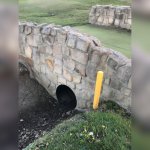Tartantoon
New member
Yesterday I hit one of my best drives and found that my ball had stopped twelve inches from a stone footbridge over a burn (a lucky break that I didn't go into the burn). I was short of the penalty area but my swing follow through would have resulted in my club hitting the wall of the bridge. There is a local rule that says if the ball comes to rest on the bridge then free relief is available. However, as I wasn't on the bridge and wasn't in the penalty area I thought I had to play it as it lies so I putted it over the bridge and played from there. My playing partner thought that I should get free relief as my swing was impeded by the bridge wall. Could someone tell me the correct ruling please?


